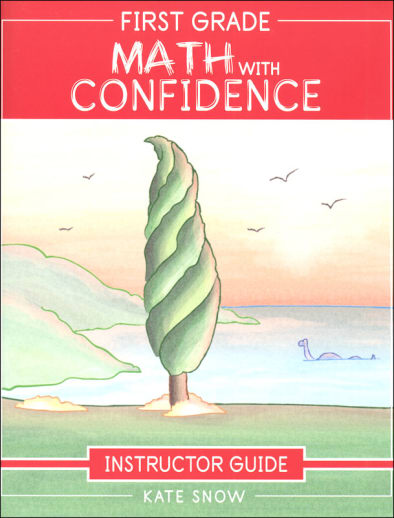Instructor Guides begin with introductory information and a helpful “how to use” section which gives parents the tools to confidently teach math. Scripted lessons for the teacher and easy to implement activities that use household items, along with a few common math manipulatives, the Instructor Guide equips parents to be successful. From Kindergarten through 2nd Grade, there are four teaching days and one optional enrichment or review day, for a total of 32 weeks. Weekly lessons have the same format: Overview of the week, lesson notes, and materials list for activities. Each lesson includes interactive teaching time and independent workbook time. Second Grade takes 20-30 minutes for each lesson. Enrichment or review activities focus on games/activities or a suggested read aloud math book of the week.
First Grade Math with Confidence Instructor Guide
Description
Comprehensive coverage of all essential first grade math topics
With this scripted, open-and-go program, parents can help their children master all the concepts typically covered in first grade:
- counting, comparing, and writing numbers to 100
- addition and subtraction facts to 20
- addition and subtraction word problems
- beginning place value and mental math
- shapes, money, time, and measurements
Your student will develop both strong number sense and a positive attitude towards math with fun activities like Addition Bingo, Pretend Store, and Measurement Scavenger Hunt. All you'll need are this Instructor Guide, the Student Workbook, and simple household or classroom items (like play money, pattern blocks, objects to count, and a ruler) to make math come alive for your student.
All student practice pages (and answers) are found in the colorful, easy-to-use Student Workbook.
Features:
- Short, scripted, hands-on, and developmentally-appropriate lessons
- Clear goals at the start of each lesson to tell you exactly what you're trying to accomplish
- Explanatory notes teach you more deeply how children learn math, equipping you for developmentally-appropriate teaching
- Checkpoints at the end of each unit give specific guidance on whether to do more review or move on
- Games, movement, and pretend activities to make math fun
- Delightful, optional weekly enrichment lessons, with picture book recommendations and real-life math extension activities
- Memory work and daily review to ensure children retain what they've learned and master essential skills
Children can commonly start grade 1 at the age of six years, or when they are able to count to at least 10, write numbers 1-10, identify basic shapes, and solve simple addition or subtraction word problems with objects. Topics include reading, writing, and comparing numbers to 100, place value to 100, mastery of addition and subtraction facts through 20, solving addition and subtraction word problems, charts and bar graphs, fractions (1/2, ¼) measurements, shapes, money, and time. Recommended manipulatives include 125 small counters, pattern blocks, coins, play money, 200 index cards, playing cards and dice, clocks with hands, 12" ruler, blank paper, pencils, and binder with plastic page protectors (2). Various household items are mentioned, for example: small toy, zip top bags, digital clock, etc.
| Product Format: | Paperback |
|---|---|
| Grade: | 1 |
| Brand: | Well-Trained Mind Press |
| ISBN: | 9781952469053 |
| Length in Inches: | 11 |
| Width in Inches: | 8.5 |
| Height in Inches: | 1.125 |
| Weight in Pounds: | 2.8937 |

